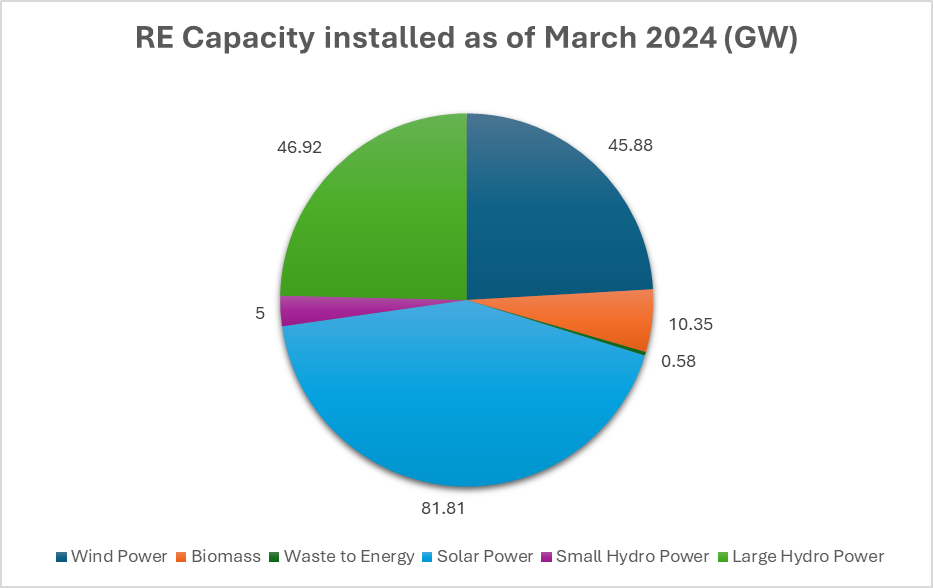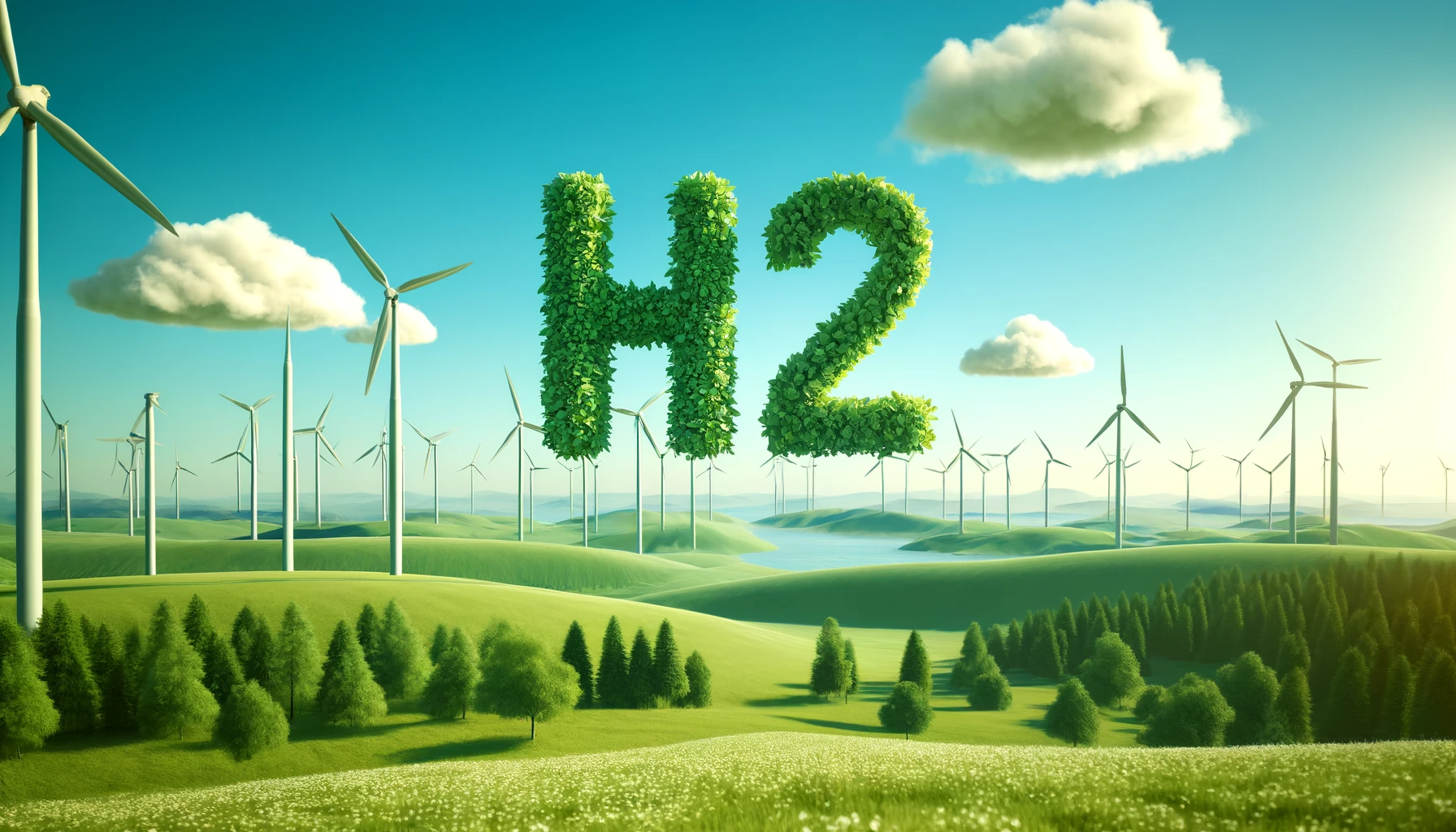Renewable energy is the cornerstone for Green Hydrogen production, ensuring sustainability. The initiative of producing Green Hydrogen is crucial for India’s journey towards achieving net-zero emissions by 2070. The National Green Hydrogen Mission, launched in 2023, targets the production of 5 million metric tonnes of Green Hydrogen annually by 2030 and 500 GW of renewable energy capacity, highlighting its commitment to a sustainable future. Currently, India ranks 4th globally in renewable energy capacity, with significant progress in solar and wind energy.
Government initiatives like the Production Linked Incentive (PLI) Scheme and the National Green Hydrogen Mission are pivotal in promoting renewable energy. This initiative aims to transition India’s energy sector to sustainable sources, reducing reliance on fossil fuels. Key components include financial incentives, pilot projects, and regulatory frameworks to support the production, utilization, and export of Green Hydrogen, positioning India as a global leader in clean energy.
The Government of India has articulated and put across the concerns of developing countries at the 26th session of the Conference of the Parties (COP26) to the United Nations Framework Convention on Climate Change (UNFCCC) held in Glasgow, United Kingdom. Further, India presented the following five nectar elements (Panchamrit) of India’s climate action:
- Reach 500 GW Non-fossil energy capacity by 2030.
- 50 per cent of its energy requirements from renewable energy by 2030.
- Reduction of total projected carbon emissions by one billion tonnes from now to 2030.
- Reduction of the carbon intensity of the economy by 45 per cent by 2030, over 2005 levels.
- Achieving the target of net zero emissions by 2070.
These ‘Panchamrits’ will be an unprecedented contribution of India to climate action.
Apart from these, the following are the additional targets to achieve by 2030.
- Five (05) million tonnes of annual production capacity of Green Hydrogen by 2030, supported by 125 GW of renewable energy.
- 50 Solar Parks with an aggregate capacity of 37.49 GW.
- Wind Energy has an offshore target of 30 GW by 2030
- 26.7 GW of Pumped Storage requirement by 2032
- 47.2 GW of BESS requirement by 2032
India’s Progress in Renewable Energy
Globally, India stands 4th in Renewable Energy Installed capacity (including Large Hydro), 4th in Wind Power capacity & 5th in Solar Power capacity (as per REN21 Renewables 2022 Global Status Report). The country has set an enhanced target of 500 GW of non-fossil fuel-based energy by 2030, at the COP26. This has been a key pledge under the Panchamrit and is the world’s largest expansion plan in Renewable Energy. India’s installed non-fossil fuel capacity has increased to 396% in the last 9 years. India assumed the presidency of the 13th Assembly of the International Renewable Energy Agency (IRENA).
As of Mar 2024, Renewable Energy sources, including large hydropower, have a combined installed capacity of 190.57 GW. The following is the installed capacity for Renewables.

Green Hydrogen
Green Hydrogen, produced through electrolysis using renewable energy, is seen as a key element in decarbonizing the economy. It addresses energy security, reduces emissions, and supports sectors where direct electrification is challenging. The mission emphasizes the development of a robust Green Hydrogen value chain, including production, storage, transportation, and application across various sectors. This initiative is essential for India to achieve its net-zero goals and enhance energy independence.
It has been determined that hydrogen will play a crucial role in enabling the world to meet its targets for limiting temperature increases to 1.5 degrees Celsius, adapting to the negative effects of climate change, and promoting the development of low greenhouse gas emissions. There was an unmistakable buzz about hydrogen in 2020. Countries all across the world are putting out bold goals, pilot programs, and significant financial commitments to build an ecosystem centered around hydrogen.
Global Initiative Towards Hydrogen Economy

Global Hydrogen Production
Hydrogen can be produced using different technologies, but sustainable production technologies will create future possibilities of adoption and scale. Today, hydrogen is mainly produced from fossil fuels such as coal & natural gas. However, it can be generated from various feedstocks. The cost of hydrogen, market-competitiveness and market-timeframe is affected by location of production technology and its volume of production.

Why is India betting big on hydrogen?
Energy security: The global pandemic has taught the nations to diversify their energy demand as well as their geographical availability. The fluctuations in the oil & gas market have disrupted supply-demand chain and causes variation in the fuel cost. Developing countries like India need to find out an alternative to strengthen its National Energy Security.
Emission targets: India is the third largest global CO2 emitter (~7% of global CO2 emission) well below China & United States. Earlier, it was committed to reduce its emissions intensity by 33-35% under the Paris Agreement which has been revised to 45% by 2030.
Economic dependencies & balance of trade: India is the world’s third largest crude oil importer with an import dependency of over 80%. It also imports 54% of natural gas and 24% of coal requirements which largely affects India’s financial account balance. India’s oil import bill in FY20 and FY19 was approx. US$101.4 billion and US$111.9 billion, respectively.
Energy Subsidies: Along with the high cost of imported fuel, India gives away overall energy subsidies of approx. US$30 bn / year on Oil & Gas, Coal, Transmission & Distribution, Renewable Energy and Electric Vehicles. Some proportion of these subsidies can be diverted for the development of hydrogen ecosystem. Hence, India can grab this early opportunity to capture entire value chain of hydrogen and look out for global exports.
Types of Hydrogen by Process of Generation

Conclusion
India’s commitment to a greener future through the National Green Hydrogen Mission is not just a bold statement but a significant step towards global environmental leadership. The focus on Green Hydrogen promises to revolutionize various sectors, offering a cleaner, more sustainable alternative to fossil fuels. This mission aligns with global efforts to limit temperature increases and adapt to climate change’s adverse effects. India’s strategies, from financial incentives to pilot projects, highlight the country’s innovative and ambitious plans to lead the global green hydrogen market.
As India continues to invest in and develop its renewable energy infrastructure, it paves the way for a future where energy security, economic stability, and environmental sustainability go hand in hand. The journey to net-zero emissions by 2070 is challenging, but with consistent efforts and global collaboration, India is well on its way to achieving this monumental goal. The Green Hydrogen Mission is not just about reducing emissions; it’s about fostering a new era of clean energy that can inspire the world to follow suit.
It is a summary of the INDIA’S GREEN HYDROGEN REVOLUTION – An Ambitious Approach Report published jointly by MNRE and EY.
This article is the first part of the 2-part series of Green Hydrogen Revolution in India. The second part is linked here.
